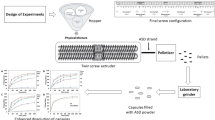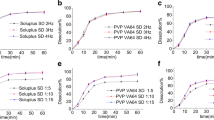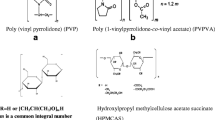ABSTRACT
Purpose
To identify molecular indicators of bulk and surface instabilities of amorphous dispersions prepared by hot melt extrusion.
Methods
Four model drugs with different physicochemical properties were formulated with EUDRAGIT® E PO using hot melt extrusion. Samples were aged under a range of conditions for up to 6 months and characterized using SEM, ATR-FTIR, PXRD and MTDSC. The effects of a range of thermodynamic, kinetic and molecular parameters, including glass transition temperature, molecular mobility, the crystallization tendency of the amorphous drug and drug-polymer miscibility, on the bulk and surface stabilities of the solid dispersions were evaluated.
Results
For all drug-containing systems, a higher degree of instability was observed at the surface of the material in comparison to the bulk. Stressed humidity showed a more profound effect on the dispersions in comparison to stress temperature, reducing both their surface and bulk stabilities. For supersaturated systems the order of the bulk and surface instabilities of the samples was found following the same order of the molecular mobilities of the amorphous model drugs. This was attributed to the presence of phase separation of amorphous drug-rich domains in the supersaturated extrudates.
Conclusions
The stability of the amorphous drug-rich domains appears to be governed by the physical stabilities of the amorphous drugs. The more commonly used indicators such as Tg, fragility of the amorphous drug and the theoretically predicted drug-polymer solubility showed less influence on the bulk and surface stabilities of the extrudates in comparison to the molecular mobility of the amorphous drug.













Similar content being viewed by others
REFERENCES
Serajuddin ATM. Solid dispersion of poorly water-soluble drugs: early promises, subsequent problems, and recent breakthroughs. J Pharm Sci. 1999;88:1058–66.
Leunerand C, Dressman J. Improving drug solubility for oral delivery using solid dispersions. Eur J Pharm Biopharm. 2000;50:47–60.
Yu L. Amorphous pharmaceutical solids: preparation, characterization and stabilization. Adv Drug Deliv Rev. 2001;48:27–42.
Qi S, Gryczke A, Belton P, Craig DQM. Characterisation of solid dispersions of paracetamol and EUDRAGIT® E prepared by hot-melt extrusion using thermal, microthermal and spectroscopic analysis. Int J Pharm. 2008;354:158–67.
Qi S, Belton P, Nollenberger K, Clayden N, Reading M, Craig DM. Characterisation and prediction of phase separation in hot-melt extruded solid dispersions: a thermal. Microscopic and NMR Relaxometry Study. Pharm Res. 2010;27:1869–83.
Hancock B, Shamblin S, Zografi G. Molecular mobility of amorphous pharmaceutical solids below their glass transition temperatures. Pharm Res. 1995;12:799–806.
Marsac P, Shamblin S, Taylor L. Theoretical and practical approaches for prediction of drug–polymer miscibility and solubility. Pharm Res. 2006;23:2417–26.
Marsac P, Li T, Taylor L. Estimation of drug–polymer miscibility and solubility in amorphous solid dispersions using experimentally determined interaction parameters. Pharm Res. 2009;26:139–51.
Qi S, Craig DM. Detection of phase separation in hot melt extruded solid dispersion formulations global vs. localized characterization. Am Pharm Rev. 2010;13:68–74.
Qian F, Huang J, Hussain MA. Drug–polymer solubility and miscibility: stability consideration and practical challenges in amorphous solid dispersion development. J Pharm Sci. 2010;99:2941–7.
Rumondorand ACF, Taylor LS. Effect of polymer hygroscopicity on the phase behavior of amorphous solid dispersions in the presence of moisture. Mol Pharm. 2009;7:477–90.
Mahieu A, Willart J-F, Dudognon E, Danède F, Descamps M. A new protocol to determine the solubility of drugs into polymer matrixes. Mol Pharm. 2012;10:560–6.
Yang Z, Nollenberger K, Albers J, Qi S. Molecular implications of drug–polymer solubility in understanding the destabilization of solid dispersions by milling. Mol Pharm. 2014;11:2453–65.
Hancockand BC, Zografi G. Characteristics and significance of the amorphous state in pharmaceutical systems. J Pharm Sci. 1997;86:1–12.
Ng YC, Yang Z, McAuley WJ, Qi S. Stabilisation of amorphous drugs under high humidity using pharmaceutical thin films. Eur J Pharm Biopharm. 2013;84:555–65.
Repka MA, Battu SK, Upadhye SB, Thumma S, Crowley MM, Zhang F, et al. Pharmaceutical applications of hot-melt extrusion: part II. Drug Dev Ind Pharm. 2007;33:1043–57.
Kalivoda A, Fischbach M, Kleinebudde P. Application of mixtures of polymeric carriers for dissolution enhancement of fenofibrate using hot-melt extrusion. Int J Pharm. 2012;429:58–68.
Maniruzzaman M, Rana MM, Boateng JS, Mitchell JC, Douroumis D. Dissolution enhancement of poorly water-soluble APIs processed by hot-melt extrusion using hydrophilic polymers. Drug Dev Ind Pharm. 2013;39:218–27.
Ke P, Hasegawa S, Al-Obaidi H, Buckton G. Investigation of preparation methods on surface/bulk structural relaxation and glass fragility of amorphous solid dispersions. Int J Pharm. 2012;422:170–8.
Qi S, Moffat JG, Yang Z. Early stage phase separation in pharmaceutical solid dispersion thin films under high humidity: improved spatial understanding using probe-based thermal and spectroscopic nanocharacterization methods. Mol Pharm. 2013;10:918–30.
Yang Z, Nollenberger K, Albers J, Moffat JG, Craig DQM, Qi S. The effect of processing on the surface physical stability of amorphous solid dispersions. Eur J Pharm Biopharm. 2014. Accepted.
Nishiand T, Wang TT. Melting point depression and kinetic effects of cooling on crystallization in poly(vinylidene fluoride)-poly(methyl methacrylate) mixtures. Macromolecules. 1975;8:909–15.
Andronisand V, Zografi G. The molecular mobility of supercooled amorphous indomethacin as a function of temperature and relative humidity. Pharm Res. 1998;15:835–42.
Yoshioka M, Hancock BC, Zografi G. Crystallization of indomethacin from the amorphous state below and above its glass transition temperature. J Pharm Sci. 1994;83:1700–5.
Qi S, Avalle P, Saklatvala R, Craig DQM. An investigation into the effects of thermal history on the crystallisation behaviour of amorphous paracetamol. Eur J Pharm Biopharm. 2008;69:364–71.
Zhou D, Zhang GGZ, Law D, Grant DJW, Schmitt EA. Thermodynamics, molecular mobility and crystallization kinetics of amorphous griseofulvin. Mol Pharm. 2008;5:927–36.
Hodge IM. Strong and fragile liquids — a brief critique. J Non-Cryst Solids. 1996;202:164–72.
Bhattacharyaand S, Suryanarayanan R. Local mobility in amorphous pharmaceuticals—characterization and implications on stability. J Pharm Sci. 2009;98:2935–53.
Baird JA, Van Eerdenbrugh B, Taylor LS. A classification system to assess the crystallization tendency of organic molecules from undercooled melts. J Pharm Sci. 2010;99:3787–806.
Van Eerdenbrugh B, Baird JA, Taylor LS. Crystallization tendency of active pharmaceutical ingredients following rapid solvent evaporation—classification and comparison with crystallization tendency from undercooled melts. J Pharm Sci. 2010;99:3826–38.
Surana R, Pyne A, Suryanarayanan R. Effect of aging on the physical properties of amorphous trehalose. Pharm Res. 2004;21:867–74.
Floryand PJ, Krigbaum WR. Thermodynamics of high polymer solutions. Annu Rev Phys Chem. 1951;2:383–402.
Rustichelli C, Gamberini G, Ferioli V, Gamberini MC, Ficarra R, Tommasini S. Solid-state study of polymorphic drugs: carbamazepine. J Pharm Biomed Anal. 2000;23:41–54.
Grzesiak AL, Lang M, Kim K, Matzger AJ. Comparison of the four anhydrous polymorphs of carbamazepine and the crystal structure of form I. J Pharm Sci. 2003;92:2260–71.
Avrami M. Kinetics of phase change. I General theory. J Chem Phys. 1939;7:1103–12.
Chawla G, Gupta P, Thilagavathi R, Chakraborti AK, Bansal AK. Characterization of solid-state forms of celecoxib. Eur J Pharm Sci. 2003;20:305–17.
ACKNOWLEDGMENTS AND DISCLOSURES
Ziyi Yang would like to thank Evonik for the financial support for the period of his PhD. The authors also would like to acknowledge the contribution of members of the Interreg IV A project funded by the European Union.
Author information
Authors and Affiliations
Corresponding author
Electronic supplementary material
Below is the link to the electronic supplementary material.
ESM 1
(DOCX 498 kb)
Rights and permissions
About this article
Cite this article
Yang, Z., Nollenberger, K., Albers, J. et al. Molecular Indicators of Surface and Bulk Instability of Hot Melt Extruded Amorphous Solid Dispersions. Pharm Res 32, 1210–1228 (2015). https://doi.org/10.1007/s11095-014-1527-8
Received:
Accepted:
Published:
Issue Date:
DOI: https://doi.org/10.1007/s11095-014-1527-8




